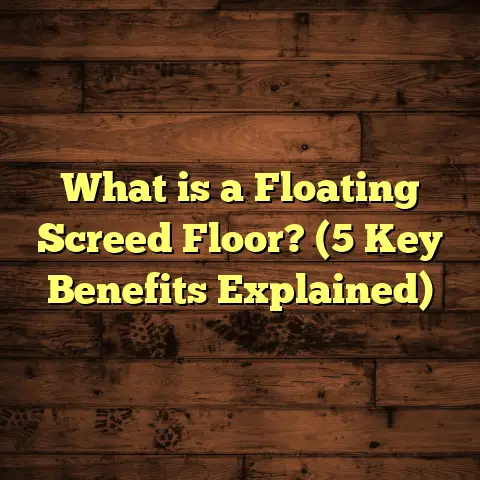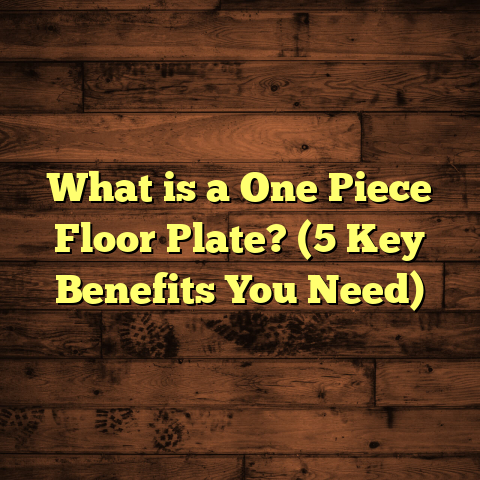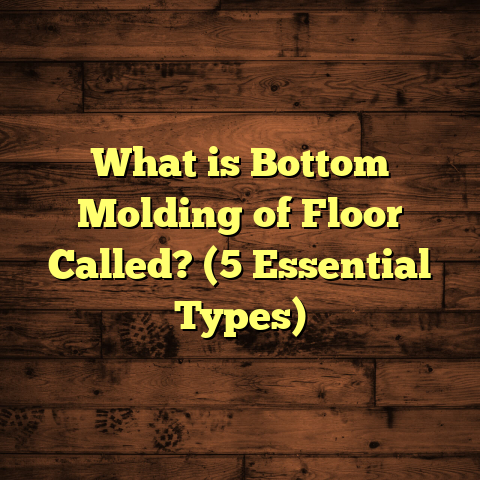What is a Floating Hardwood Floor? (5 Key Benefits Explained)
Have you ever wondered how a flooring choice can completely change the feel of your home? Maybe you’re dreaming of that warm, inviting hardwood look but worry about installation complexity or cost. I’ve spent years working as a flooring contractor and have installed countless floors, including floating hardwood floors. Let me walk you through exactly what a floating hardwood floor is and why it might be the best fit for your space.
What Is a Floating Hardwood Floor?
A floating hardwood floor is a method of installing hardwood planks where the floor isn’t nailed or glued directly to the subfloor beneath it. Instead, the planks attach to each other through a locking mechanism—usually a click-lock or tongue-and-groove system—and “float” above the subfloor. An underlayment is often placed between the subfloor and the floating floor to provide cushioning, soundproofing, and moisture protection.
This contrasts with traditional hardwood floors that are nailed or glued down directly. Because floating floors aren’t fixed to the subfloor, they can expand and contract naturally with changes in temperature and humidity, which helps prevent many common flooring problems.
Why Is This Important?
When I first started installing floating floors years ago, I immediately noticed how much less hassle it was compared to traditional methods. You don’t need heavy equipment or nails; it’s almost like assembling a large puzzle. Plus, this method opens up options for different subfloors that wouldn’t normally support nailed-down wood, like concrete slabs.
Types of Floating Hardwood Floors
Mostly, when people talk about floating hardwood floors, they’re referring to engineered hardwood. Engineered hardwood consists of a thin veneer of real hardwood on top of a plywood or high-density fiberboard core. This layered construction adds stability and makes it compatible with floating installation systems.
Here are common types:
- Engineered hardwood with click-lock system: Planks snap together edge-to-edge without glue.
- Engineered hardwood with tongue-and-groove: Planks fit together but require adhesive on the joints.
- Hybrid floating floors: Some combine vinyl or laminate cores with hardwood veneers for extra durability.
Solid hardwood floors rarely use floating installation because solid wood expands and contracts more dramatically.
1. Easier and Faster Installation
If you’re someone who values speed and simplicity, floating hardwood floors shine here.
Installation Process
Unlike traditional nail-down floors that require pounding nails into the subfloor one plank at a time—an exhausting and time-consuming process—a floating floor uses interlocking planks that click or fit snugly together. You start by laying down an underlayment (usually foam or cork), which smooths out imperfections in the subfloor and adds sound insulation.
From there, you simply connect the planks row by row. Since no nails or glue are needed on the subfloor, cleanup is minimal. For many DIYers and contractors I’ve worked with, this installation method drastically reduces labor hours.
My Experience on the Job
I remember a project where we were on a tight deadline for a client’s living room renovation. The old carpet had to come out, but we couldn’t disrupt their schedule much. Floating hardwood installation let us work efficiently over two days instead of four or five. They were amazed at how quickly their new floor came together.
Time Savings Data
Industry reports suggest floating hardwood floors can cut installation time by 30-50%, depending on room size and complexity. This translates to big savings on labor costs if you hire professionals—or less frustration if doing it yourself.
2. Cost-Effective Flooring Solution
Everyone wants beautiful hardwood without breaking the bank. Floating hardwood floors offer an affordable way to get that look.
Material Costs
Engineered hardwood designed for floating installation generally costs less than solid hardwood planks. For example:
| Flooring Type | Average Cost per Sq Ft (Material Only) |
|---|---|
| Solid Hardwood | $6 – $12 |
| Engineered Hardwood | $4 – $8 |
| Laminate (Floating) | $2 – $5 |
Engineered hardwood’s layered construction uses less expensive base materials, making it more budget-friendly without compromising on surface appearance.
Labor Costs
Since floating floors install faster and require fewer tools and materials (nails, adhesives), labor charges are lower. On average, installing floating hardwood floors costs about $3-$6 per square foot labor-wise compared to $5-$10 for nail-down methods.
Savings on Subfloor Prep
Floating floors can often be installed directly over existing hard surfaces like vinyl, tile, or concrete. This means you avoid costly demolition and disposal fees associated with removing old floors.
Real Client Story About Budgeting
One homeowner I worked with wanted a hardwood look but had a tight budget for their basement remodel. We chose an engineered hardwood floating floor installed directly over the concrete slab with moisture barriers underneath. This kept costs manageable while delivering a warm aesthetic they loved.
3. Greater Stability and Durability
Hardwood floors face challenges from temperature fluctuations and humidity changes, which can cause warping, gaps, or buckling if not properly installed.
How Floating Floors Handle Movement
Because floating floors aren’t fixed rigidly to the subfloor, they can move slightly as conditions change. This natural flexibility prevents stress on the wood joints that often leads to damage in nailed-down floors.
Moisture Resistance
While no wood flooring is fully waterproof, engineered hardwood floating floors handle moisture better than solid wood nailed-down floors due to their cross-layered core construction.
Case Study: Coastal Home Flooring
I once helped a family in a humid coastal town replace their aged traditional hardwood floors that had severe cupping and warping issues. The new floating engineered hardwood floor with a moisture-resistant underlayment has held up beautifully for over 6 years despite seasonal humidity swings.
Durability Tips
- Use proper underlayment to protect from moisture
- Maintain indoor humidity levels around 40-50%
- Avoid excessive water during cleaning
4. Versatility Over Different Subfloors
This is one of my favorite benefits because it opens up possibilities for spaces that otherwise wouldn’t support hardwood floors.
Compatible Subfloors
Floating hardwood floors can be installed over:
- Concrete slabs: Often found in basements or modern constructions.
- Existing tile or vinyl floors: Avoids demolition.
- Plywood or OSB subfloors: Standard in many homes.
- Radiant-heated floors: Some engineered woods work well here due to dimensional stability.
Why This Matters
I’ve worked on projects where clients wanted new hardwood but didn’t want the mess or expense of removing old tile or vinyl. Floating floors let us install right over these surfaces after cleaning and using appropriate underlayment.
Personal Example
In an apartment renovation, we floated engineered hardwood over an old linoleum floor. The client saved thousands in demolition costs and had their new floor ready in just days.
5. Easy Maintenance and Repair
Keeping your floor looking great long-term is just as important as installing it well.
Maintenance Made Simple
Floating hardwood floors clean like other hardwoods—with regular sweeping or vacuuming and occasional damp mopping (never soaking). The underlayment helps reduce noise and adds comfort underfoot.
Repairing Damage
If a plank becomes scratched, dented, or stained beyond simple cleaning, repairs are straightforward:
- Identify damaged plank
- Carefully remove surrounding planks if necessary
- Replace with new matching plank
This modular nature is a huge plus compared to glued-down floors where repairs can be extensive and costly.
Anecdote From My Work
I had a client whose dog scratched several planks after playful roughhousing. Instead of replacing the entire floor section, we swapped out just those planks within an hour at minimal cost.
Additional Insights: Sound Insulation Benefits
One thing I didn’t expect when installing floating floors was how much quieter they felt underfoot compared to some nailed-down hardwoods. The underlayment acts as a sound buffer, reducing footsteps and echo—great for multi-story homes or apartments.
Industry tests show that foam or cork underlayments can reduce impact noise by up to 20 decibels versus no underlayment.
Environmental Considerations
Engineered hardwood used in floating floors tends to use less slow-growing solid wood because only the top veneer is real wood. This makes it somewhat more environmentally friendly when sourced responsibly.
Look for products certified by organizations like:
- Forest Stewardship Council (FSC)
- Sustainable Forestry Initiative (SFI)
These certifications ensure wood comes from sustainably managed forests.
Common Questions I Get Asked About Floating Hardwood Floors
Q: Can I install floating hardwood myself?
Absolutely! Many DIYers find floating floors manageable because they don’t require nails or glue on the subfloor. Just make sure you prepare your subfloor well and follow manufacturer instructions carefully.
Q: Are floating hardwood floors noisy?
With proper underlayment, noise is minimal—often quieter than traditional nailed-down wood floors.
Q: Can I refinish floating hardwood floors?
Engineered hardwood veneers are thinner than solid wood; most allow refinishing once or twice depending on veneer thickness (usually between 2mm–4mm).
Tools and Materials You’ll Need for Installation
If you’re considering installing a floating hardwood floor yourself, here’s what you’ll typically need:
- Underlayment foam or cork rolls
- Tape measure and chalk line
- Utility knife
- Rubber mallet
- Spacers (to maintain expansion gaps)
- Saw (miter saw or jigsaw)
- Pull bar for tight spaces
- Tapping block to lock planks together
Final Thoughts From My Experience
Floating hardwood floors offer an excellent blend of beauty, practicality, and affordability. They’re especially great if you want fast installation over various subfloors without worrying about nails or glue damage.
If you want durable flooring that’s easier to repair and maintain long-term—or if your renovation timeline is tight—floating engineered hardwood could be exactly what you need.
Have you thought about trying one? Or maybe you’ve already had experience? I’d love to hear what worked for you or answer any questions based on what I’ve seen in my career!





